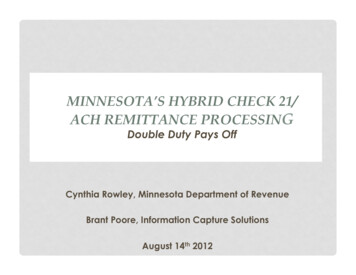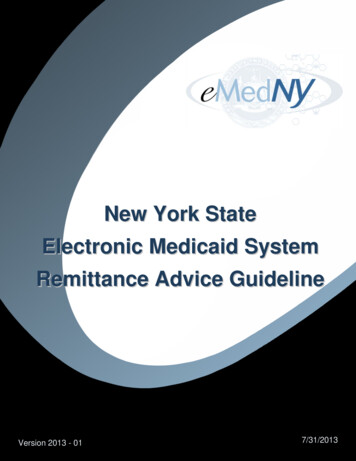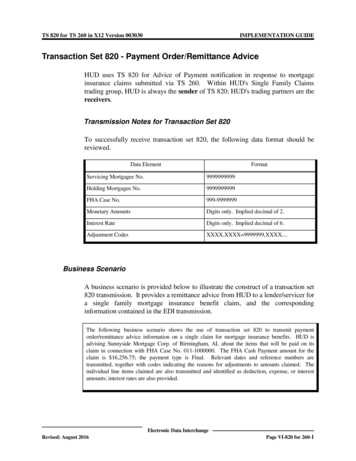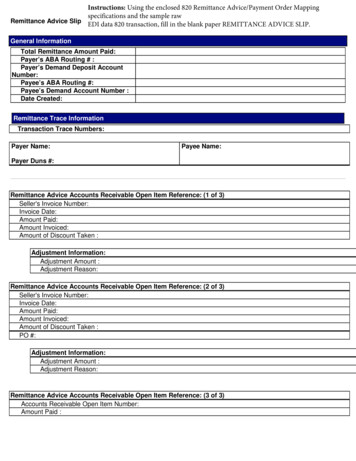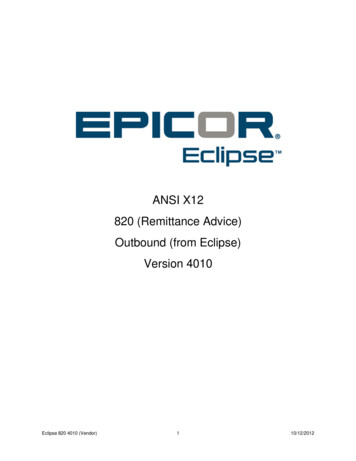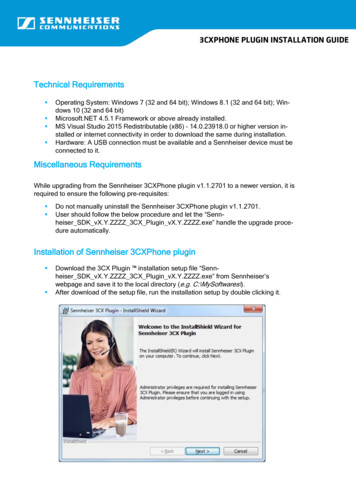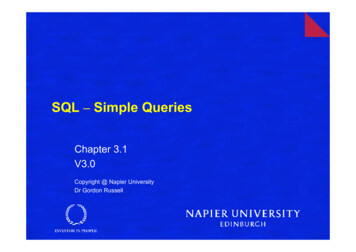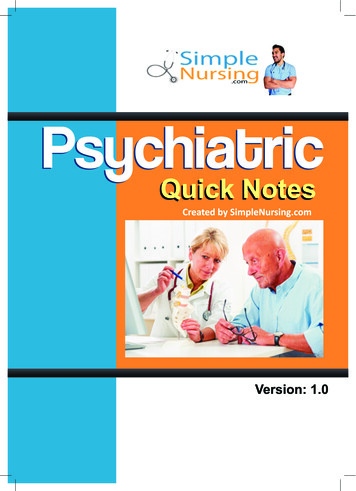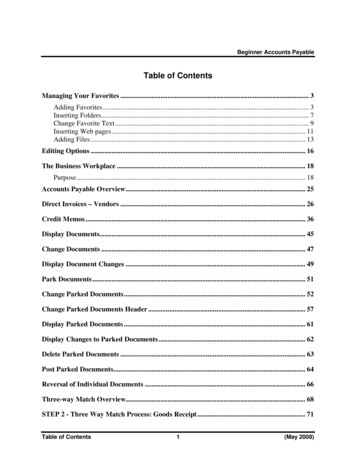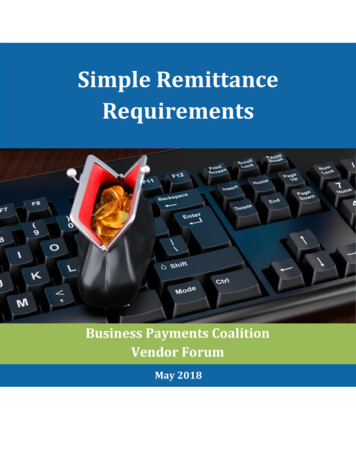
Transcription
Simple RemittanceRequirementsBusiness Payments CoalitionVendor ForumMay 2018
TOCSimple Remittance RequirementsTable of ContentsOverview . 2Background . 3Three Remittance Data Levels . 4Uses and Examples. 7Level 1 Examples . 7Level 2 Examples . 7Level 3 Examples . 8Conclusion . 8Work Group Members . 8Appendix – Terminology . 9
2Simple Remittance RequirementsOverviewThe Simple Remittance Requirements initiative is a project of the Business Payments Coalition’s VendorForum. The Business Payments Coalition (BPC) is a volunteer group of organizations and individualsworking together to promote greater adoption of electronic business-to-business (B2B) payments,remittance data and invoicing. The Coalition’s overarching goal is to make B2B electronic paymentsmore efficient across the end-to-end process; that is, to achieve straight-through-processing. TheCoalition accomplishes this objective by addressing problems and barriers that make it difficult forbusinesses to use electronic alternatives to paper checks and remittance advices.The mission of the work group was narrow and targeted:To define data needs for simple remittance information that can be easilyadopted by small and medium size businesses (SMBs).The group was tasked with identifying three or four levels of remittance data based on needs of SMBs,starting with the minimal, viable set of data needed for cash application and reconciliation, andincrementally adding data for two or three additional levels to accommodate different businesscapabilities. The group also reviewed data in existing remittance message standards (e.g. ISO 20022 andEDI X12) and data available in SMB accounting software. Data needs are payment-method agnostic andintended to facilitate B2B payments. As the group focused on data only, payment standards work andthe remittance delivery method were out of scope.This document presents the work product of the group as well as a glossary of relevant terminology. Thesource of the glossary is the Remittance Glossary developed by the BPC in 2013.Stakeholders represented by the volunteer participants included payments service providers,consultants, payment systems providers, and standards organizations. The Federal Reserve Bank ofMinneapolis facilitated the work group.The intent of this work product is to: Highlight the needs of the SMB market segmentProvide guidelines for minimum remittance dataDocument payment and remittance terminology for consistency and interoperabilityServe as a foundational building block for other remittance effortsServe as a resource for industry discussionsThe work product is not intended to be used as a new data standard, nor does it includedata structures, format or syntax for remittance strings. Practitioners building systems thatsend or consume remittance messages, however, may use it in defining a subset of anexisting standard for improved interoperability and increased straight-through-processing.
3Simple Remittance RequirementsWhat should different readers take away from this document? How would they use this information?The table below will help with those questions.If you are Key Take-away(s)Possible outcome(s)AP/AR service providerto SMBIncorporate the fields based on thelevels defined.Provide capabilities for each level.Software provider toSMBEvaluate the data levels to determinewhich levels your products support.Provide capabilities at one or morelevels that include user interfacedesign and data mapping tosupport the data.System/applicationconsultant to SMBUnderstand the differences amongthe several levels of data content.Discuss the value of creating processflows needed to use the data.Guide SMB clients to recognize andadopt data levels suitable for theiruse.SMB accounting staffBe aware that this guideline existsand how it can benefit youraccounting process.Ask if your providers have solutionsthat incorporate the data so it fitsyour business process.A large company tryingto improve straightthrough processing withyour SMB tradingpartnersRecognize the limits of your partners’capabilities and incorporate the datathey can send or ingest.Incorporate trading partnercapabilities into your on-boardingprocess.BackgroundSMBs have a variety of challenges with sending and receiving electronic payments, which are widelyknown in the payment industry. Data needed to accurately apply cash to Accounts Receivable balances(cash application) is generally provided with checks, but may not be provided with electronic paymentssuch as ACH or card payments. To facilitate automated processing, the data must be aligned from theAccounts Payable (AP) and Accounts Receivable (AR) perspectives so that AP software can send theinformation needed by AR software for cash application1. There are several challenges that must beaddressed to facilitate this alignment including a) accommodating the fact that the “desired” data maynot be available in the systems or business processes used by SMBs, b) communicating those limitations,and c) correctly defining and interpreting the data that is exchanged.SMB accounting software is less complex than ERP software in order to serve basic needs of SMBs, whogenerally don’t have IT support for implementation and maintenance. SMBs are constrained by thecapabilities of their accounting software, even when sending payments to or receiving payments from1Throughout this document (except the appendix), the term “AP” refers to Accounts Payable, the buyer, and thepayer. “AR” refers to Accounts Receivable, the supplier, and the payee.
4Simple Remittance Requirementslarge businesses. Identifying and documenting basic standard data elements can facilitate support bySMB accounting software and payment service providers.The work group reviewed SMB accounting packages2 to determine what data can be supplied withelectronic AP payments and what data can be ingested for cash application to AR balances. Oneoutcome of the review is that terminology is inconsistent amongst software and service providers, sostandard and consistent terminology is needed by the industry to assure interoperability.The work group reviewed data elements provided by existing standards, such as ISO 20022, Fedwire ,IFX, and EPN STP 820 (which is a subset of larger EDI X12 standards), to assure that data elements wouldbe compatible with existing standards. These and other standards are generally too complex or tooextensive for SMBs or SMB accounting software to adopt; however, it is important to be able to mapdata to and from a variety of standards specifications.This work product is a building block for future initiatives to promote electronic remittance adoption, sothat the needs of SMBs are considered in those efforts.Three Remittance Data LevelsElectronic payments include basic payer information with the payment itself, such as payer name andother identifying information. Some of this information may be used in payment application. Additionalinformation about what is being paid (remittance data) is needed to apply the cash to a customeraccount. The work group developed three levels of remittance data3 that apply to the majority of SMBs.The group focused on mainstream SMBs and did not consider specialty industries that have unique dataneeds. Specialty industry considerations could be addressed by a future initiative.There are variations in billing practices and the data needed to apply cash based on billers’ AR systems.Some billers don’t use unique invoice numbers, but rather rely on a customer account number andbilling date. This is widespread in the utility and telecommunications industries, for example. Otherbillers rely heavily on the invoice identifier to apply payments. To recognize these variants, either (a)invoice number or (b) account number plus invoice date is required. Both invoice number and customeraccount number may be provided.1. The first level has the four minimum data elements that would be needed in most cases to applya payment.2. The second level adds information about discounts and adjustments and allows for additionalinformation in the remittance.2The group reviewed the most commonly used software: Intuit’s QuickBooks, QuickBooks Online, MicrosoftDynamics Great Plains, Oracle NetSuite, Freshbooks, and Xero. There are other software packages available.3The term “data level” in this context should not be confused with “data levels” of credit card transactions, whichmay contain remittance data.
5Simple Remittance Requirements3. The third level is the EPN STP 820 transaction set, a standard developed by the ElectronicPayments Network, the ACH processing business of The Clearing House. The NACHA standardCTX file format for ACH transactions accommodates STP 820. As originally envisioned when theSTP 820 standard was developed, this level of data would generally be the most extensive setreadily available to SMBs and is therefore the most detailed level defined in this document.SMB accounting software and existing standards in the marketplace use different terminology. The dataelements in the levels are defined in the Terminology Appendix for use in mapping data for consistency.Research into accounting software indicates that the data elements are widely supported.The data elements for the three levels follow.Note: STP 820 defines data elements in groupings called “segments”. Segments are generally identifiedby a three-letter abbreviation such as RMR, DTM, ADX and REF plus a numeric indicator. We includereferences to the specific data segment elements in the table (Figure 1) on the following page tofacilitate mapping and to avoid repetition of definitions well-documented elsewhere. The STP 820implementation Guide is available at ch.RMR Remittance Advice AR Open Item ReferenceDTM Date/Time ReferenceADX AdjustmentREF Reference Identification
6Simple Remittance RequirementsLevel 1Invoice Number– and/or –CustomerAccount Number(see Note)Amount PaidInvoice DateLevel 2RROLevel 3 - EPN STP 820Invoice Number– and/or –Customer AccountNumber(see Note)Amount PaidInvoice DateRInvoice AmountODiscountAdjustmentOOOther ReferenceIdentifierDescriptionROOOReference Identifier (RMR02) – value, i.e.Invoice Number (see note)Customer Account Number (N104) – inname segment (see Note)RAmount Paid (RMR04) – the net amountInvoice Date (DTM02)Reference Identification Qualifier(RMR01) – type of documentInvoice Amount (RMR05) – the total orgross amountDiscount taken (RMR06)Adjustment Amount (ADX01)Adjustment Reason Code (ADX02) – froma list of valid STP 820 codesAdjustment Identifier (ADX04) –descriptive dataReference Identifier Qualifier (REF01) –reference type from a list of valid STP 820codesReference Identifier (REF02) – option fora second reference valueDescription (REF03)RRRROOOOOOOOFigure 1: In the table, R denotes the data is Required and O denotes the data is Optional.Note: Either invoice number or customer account number is designated as a required data element.Both may be provided.Multiple items may be included in one payment. The total amount paid is the sum of “Amount Paid” forall line items. For invoice items, the Amount Paid is positive; for credit memo items, negative.The field Other Reference Identifier is not specifically defined. It is for AR and AP use as understoodbetween the parties.
7Simple Remittance RequirementsUses and ExamplesRemittance data provides detail in a number of payment scenarios, such as: Paying against an invoicePaying against a balance forward accountTaking discountsDifferentiating discounts vs. adjustmentsThe following examples illustrate remittance data only, not the “header level” or payment instructiondata. The amount of payment is included for clarity.Level 1 ExamplesLevel 1 has basic data only. Businesses might use level 1 if they enter minimal information into their APsystem. Example A is a payment for an invoice, while Example B is a payment on account. Example Cincludes both invoice and account number.Example ATotal Payment AmountInvoice NumberAccount NumberAmount PaidInvoice Date 291.77683525 291.7702/11/2017Example B 291.77123456 291.7702/11/2017Example C 291.77683525123456 291.7702/11/2017Level 2 ExamplesLevel 2 adds more information, including discounts, adjustments, and additional reference information.Businesses that include such detail in their AP systems can include it with the remittance data. Example Ais a single invoice payment. Example B is a payment for two invoices, one of which has a discount,adjustment, and more reference information. Example C is a single invoice payment with a discount,adjustment and more reference information.Example ATotal Payment AmountInvoice NumberAmount PaidInvoice DateInvoice AmountDiscountAdjustmentOther Reference NumberDescription 4,129.27683528 4,129.2705/31/2017 4,129.27 0.00 0.00Example BExample C 714.22 3,716.34AB3947AB3948683529 214.22 500.00 3,716.3406/11/201706/13/201707/01/2017 214.22 544.18 4,129.27 0.00 -24.18 -82.58 0.00 -20.00 -330.3556411564323490Widget Items2% Net 10
8Simple Remittance RequirementsLevel 3 ExamplesLevel 3 is the STP 820 specification. The examples illustrate how the data would be used within the STP820. These examples use the same information as the Level 2 examples for comparison. Additionalcodes and identifiers are added per the specification.Example ATotal Payment AmountRMR01 - Type of DocumentRMR02 - InvoiceRMR04 - Amount PaidRMR05 - Invoice AmountRMR06 - DiscountDTM02 - Invoice DateADX01 - Adjustment AmountADX02 - Adjustment ReasonCodeREF01 - Reference ID QualifierREF02 - Reference IdentifierREF03 - Description 4,129.27IV683528 4,129.27 4,129.27 0.0005/31/2017 0.00Example BExample C 714.22 3,716.34IVIVIVAB3947AB3948683529 214.22 500.003,716.34 214.22 544.18 4,129.27 0.00 -24.18 -82.5806/11/201706/13/201707/01/2017 0.00 -20.00 -330.3504CMPO56411564Widget ItemsPO3234902% Net 10ConclusionThis document provides specific guidance for payments industry participants to address the needs ofSMBs for remittance data. The BPC work group calls for accounting software and payment serviceproviders to incorporate this guidance into their products, services and business processes.Collaborative industry efforts would extend capabilities on the AP and AR side to enable straightthrough-processing of electronic payments for SMBs. SMBs have constraints that should be recognized.The BPC encourages continued industry discussion and will use this foundational work product inongoing efforts to promote adoption of electronic remittance information.Work Group MembersThe BPC thanks the work group members for their contribution to this initiative. 4Roger Bass, TraxiantGlenn Fromer, Treasury SoftwareSharon Jablon, The Clearing HouseCaston Jackson, SurePay Financial Services, LLC4David Jackson, MarketcyRich Urban, IFX ForumPatti Ritter, Federal Reserve Bank of Minneapolis(facilitator)The views expressed in this document are those of the work group and do not necessarily reflect the views of theFederal Reserve Bank of Minneapolis, the Federal Reserve System, or the organizations of the participants.
9Simple Remittance RequirementsAppendix – TerminologySource: Remittance Glossary (Developed by the BPC in 2013)X9 TR-43–2013Technical Report of the Accredited Standards Committee X9Financial Industry StandardsThis Appendix is a subset of terms in the Glossary related to remittance and cash application.TermDefinitionAdjustmentA change initiated by a buyer to an invoiced amount resulting in adifference in the actual amount paid due to taking a discount, deduction,allowance, or credit.A deduction to the invoiced amount permitted by the seller for variousreasons to the buyer for defined events such as advertising, new storeopening, or a promotional event.A computerized procedure based on a series of algorithms enablingpayments to be quickly and automatically applied to a customer's accountwith the goal of increased accuracy and a high hit rate, which is also used todescribe the degree of "Straight Through Processing."The process of applying customer payments against outstanding accountsreceivable. For B2B payments, this is usually accomplished by the open itemapproach. If a customer has a credit limit, the process frees up the amountof the credit limit for additional purchases.The numeric identifier that distinguishes a customer account in a seller'sAccounts Receivable system. The customer account is generally tied to ahierarchical structure of accounts including the corporate entity, billing,paying, and shipping account/addresses. Similar terms used are: customeraccount number, billing account number or payer ID. In this context, it doesnot refer to a bank "Account Number".A document prepared by a customer informing the supplier that thecustomer is reducing the amount paid on a merchandise invoice due to areturn, cancellation or a claimed allowance.A short payment taken by the customer in the payment of a merchandiseinvoice. Deductions may be authorized and preapproved by the seller ormay be unauthorized and unknown by the seller until they are received.Authorized deductions may include reasons such as advertising, allowancesfor damages/shortages, new store opening discounts, and otherpromotional events. Unauthorized deductions include reasons such ascompliance violations, early/late deliveries and shortages.A reduction in price granted by the seller and included in the paymentterms for specific events that are usually under the control of the buyer,such as early payment or cash payment.Allowance (Authorized)Automated CashApplication or AutoCashCash ApplicationCustomer AccountNumber or AccountNumberDebit Memo or DebitMemorandumDeduction - Authorizedand UnauthorizedDiscount
10Simple Remittance RequirementsTermDefinitionEPN - ElectronicPayment NetworkThe private-sector U.S. automated clearing house (ACH), operated by TheClearing House/EPN. FedACH and EPN are "ACH Operators." EPN customersare financial institutions that send and receive files of ACH debits or credits.EPN processes approximately half of the commercial bank ACH transactionsin the U.S.The total amount before making any deductions or taking any discounts.An itemized bill from a seller (e.g., vendor) indicating the items purchased,price of each item, total value of the purchase, and payment terms.The full amount the customer is expected to pay. The amount left afternecessary deductions have been made from the gross amount. Alsoreferred to as the "payment amount."A document (paper or electronic) produced by a buyer or customer torequest purchase of goods or services. It will define the quanti
IFX, and EPN STP 820 (which is a subset of larger EDI X12 standards), to assure that data elements would . data to and from a variety of standards specifications. This work product is a building block for future initiatives to prom
